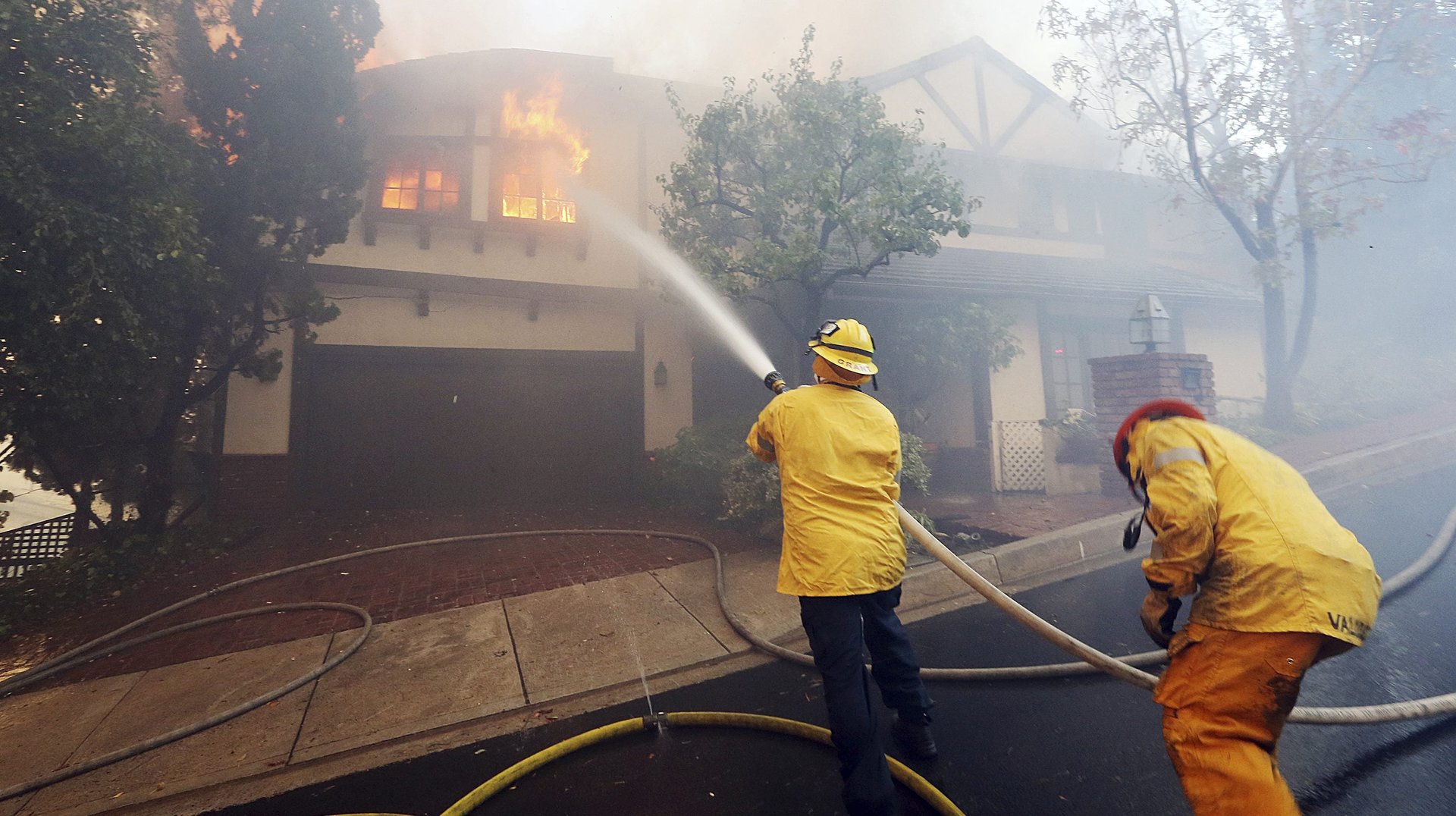The lifestyles of LA’s rich and famous include concierge firefighters
Massive wildfires in Southern California have burned more than 100 acres in the past few days, forcing thousands of people to evacuate. Most grab their valuables and run, hoping that the already-stretched local fire department will arrive in time to preserve their homes, should that be necessary.


Massive wildfires in Southern California have burned more than 100 acres in the past few days, forcing thousands of people to evacuate. Most grab their valuables and run, hoping that the already-stretched local fire department will arrive in time to preserve their homes, should that be necessary.
But many residents of the Los Angeles area’s most exclusive neighborhoods have greater peace of mind. They can decamp to, presumably, a luxury hotel, with the knowledge that private firefighters will be rushing in to fireproof their properties, or even tame nearby flames that put their posh homes in jeopardy.
Wildfire Defense System, whose president David Torgenson talked to Quartz, is one of the firms that has been dispatching crews to protect homes in at-risk zones this week. Such private firefighters clear combustible objects around a house, including patio furniture or leaves on the roof. They also often spray the perimeter of a property or the home itself with fire-blocking gels and foams, and they may arrive with their own sprinklers or water, although they can also hook up to public hydrants.
According to the Wall Street Journal (paywall), some private firefighters will even snap and email photos of a secured home to its worried owner.
The costs of these services are not billed to individual clients directly, but to insurers like AIG and Chubb, which have been offering private fire protection as an added coverage option in fancier and fire-prone ZIP codes since 2005 and 2008, respectively, the Journal also reports. Homeowners can pay several thousand dollars annually for the extra layer of insurance, depending on the value of their lairs. And in hundreds of ZIP codes in 18 states, they do.
The National Wildfire Suppression Association says its members include 150 private firefighting resource companies across the country, or 12,000 firefighters and support staff, who often respond to fires under contracts with federal, state, and local agencies.
For the insurer, the business model works brilliantly: Private firefighting may be costly (prices vary depending on the type of equipment and size of crew required), but even at its priciest does not compare with the expense of paying out a policyholder whose multimillion-dollar house has been charred.
To writer and climate activist Naomi Klein, however, the entire system is a sign that “disaster apartheid” is here: As climate change promises to introduce destructive weather events with increasing regularity, what “surviving” a crisis means will diverge greatly along income lines, she argues.
Klein, who first coined the phrase in her 2008 book Shock Doctrine, recently told the Intercept that the situation in California exemplifies it. The rich have luxuries like AIG’s special Wildfire Protection Unit, while, she noted, “4,000 of California’s state firefighters are prison inmates being paid between one and two dollars an hour to fight fires.”
Disaster apartheid, Klein said, is “rapidly accelerating,” and firefighting is only one way that it has materialized.
Pat Durland of Stone Creek Fire, an Idaho-based wildfire mitigation consultant, concedes that private firefighting is a growing category, but wouldn’t say he’s witnessed “significant growth.” It’s still a niche market, he points out. “You’d have to invest in the right equipment and the right personnel and then sit around and wait for something to happen.” Durland says it’s not an easy “startup kind of thing.”
Both Durland and Torgenson tell Quartz that the media has painted a warped picture of the way their industry works. For instance, private firms are required to work closely with the state-controlled incident command posts that are set up to coordinate responses to a wildfire, and never operate independently of them.
Since his firm was launched in 2008, Torgenson’s company has gained approval to go behind evacuated lines during more than 400 incidents, he says. To get that kind of access, his crew has had to meet all the same certification requirements as public firefighters.
What’s more, although media portrayals of private firefighters, which also appeared in Napa last month, often spotlight a dramatic tale of a private crew, say, pumping water from a client’s swimming pool onto incoming flames, that’s not what the typical response looks like. For-hire firefighters are almost always sent out before the fire has arrived, Torgenson explains.
Notably, he adds, a minority of insurance services cater exclusively to the affluent. Ninety percent of the properties covered by the companies his firm partners with are average-priced homes, he says, “and we do the majority of this work in the country.”
Nevertheless, it’s a two-tiered response to one common enemy. And insurance companies tend to get new clients whenever there’s a big fire and people see their neighbors receiving special treatment. (Although it’s still rare, homeowners can also contract private firefighters directly and some companies do market themselves exclusively to ultra-rich, says Durland.)
Wildfires may not distinguish between income levels, but, one day, our responses to them might.